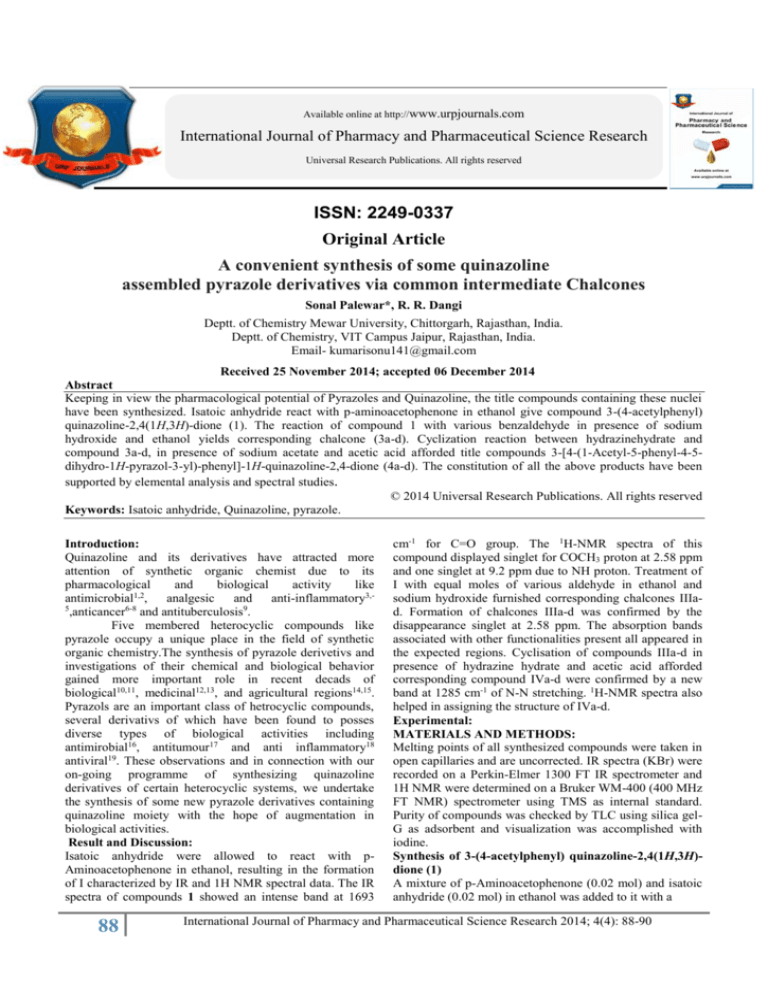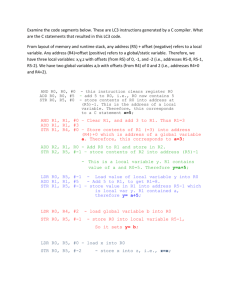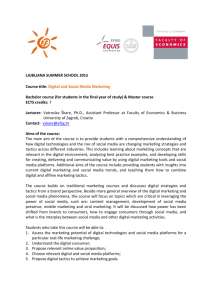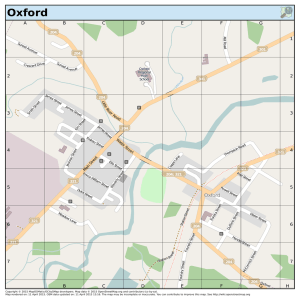
Available online at http://www.urpjournals.com
International Journal of Pharmacy and Pharmaceutical Science Research
Universal Research Publications. All rights reserved
ISSN: 2249-0337
Original Article
A convenient synthesis of some quinazoline
assembled pyrazole derivatives via common intermediate Chalcones
Sonal Palewar*, R. R. Dangi
Deptt. of Chemistry Mewar University, Chittorgarh, Rajasthan, India.
Deptt. of Chemistry, VIT Campus Jaipur, Rajasthan, India.
Email- kumarisonu141@gmail.com
Received 25 November 2014; accepted 06 December 2014
Abstract
Keeping in view the pharmacological potential of Pyrazoles and Quinazoline, the title compounds containing these nuclei
have been synthesized. Isatoic anhydride react with p-aminoacetophenone in ethanol give compound 3-(4-acetylphenyl)
quinazoline-2,4(1H,3H)-dione (1). The reaction of compound 1 with various benzaldehyde in presence of sodium
hydroxide and ethanol yields corresponding chalcone (3a-d). Cyclization reaction between hydrazinehydrate and
compound 3a-d, in presence of sodium acetate and acetic acid afforded title compounds 3-[4-(1-Acetyl-5-phenyl-4-5dihydro-1H-pyrazol-3-yl)-phenyl]-1H-quinazoline-2,4-dione (4a-d). The constitution of all the above products have been
supported by elemental analysis and spectral studies.
© 2014 Universal Research Publications. All rights reserved
Keywords: Isatoic anhydride, Quinazoline, pyrazole.
Introduction:
Quinazoline and its derivatives have attracted more
attention of synthetic organic chemist due to its
pharmacological
and
biological
activity
like
antimicrobial1,2, analgesic
and anti-inflammatory3,5
,anticancer6-8 and antituberculosis9.
Five membered heterocyclic compounds like
pyrazole occupy a unique place in the field of synthetic
organic chemistry.The synthesis of pyrazole derivetivs and
investigations of their chemical and biological behavior
gained more important role in recent decads of
biological10,11, medicinal12,13, and agricultural regions14,15.
Pyrazols are an important class of hetrocyclic compounds,
several derivativs of which have been found to posses
diverse types of biological activities including
antimirobial16, antitumour17 and anti inflammatory18
antiviral19. These observations and in connection with our
on-going programme of synthesizing quinazoline
derivatives of certain heterocyclic systems, we undertake
the synthesis of some new pyrazole derivatives containing
quinazoline moiety with the hope of augmentation in
biological activities.
Result and Discussion:
Isatoic anhydride were allowed to react with pAminoacetophenone in ethanol, resulting in the formation
of I characterized by IR and 1H NMR spectral data. The IR
spectra of compounds 1 showed an intense band at 1693
88
cm-1 for C=O group. The 1H-NMR spectra of this
compound displayed singlet for COCH3 proton at 2.58 ppm
and one singlet at 9.2 ppm due to NH proton. Treatment of
I with equal moles of various aldehyde in ethanol and
sodium hydroxide furnished corresponding chalcones IIIad. Formation of chalcones IIIa-d was confirmed by the
disappearance singlet at 2.58 ppm. The absorption bands
associated with other functionalities present all appeared in
the expected regions. Cyclisation of compounds IIIa-d in
presence of hydrazine hydrate and acetic acid afforded
corresponding compound IVa-d were confirmed by a new
band at 1285 cm-1 of N-N stretching. 1H-NMR spectra also
helped in assigning the structure of IVa-d.
Experimental:
MATERIALS AND METHODS:
Melting points of all synthesized compounds were taken in
open capillaries and are uncorrected. IR spectra (KBr) were
recorded on a Perkin-Elmer 1300 FT IR spectrometer and
1H NMR were determined on a Bruker WM-400 (400 MHz
FT NMR) spectrometer using TMS as internal standard.
Purity of compounds was checked by TLC using silica gelG as adsorbent and visualization was accomplished with
iodine.
Synthesis of 3-(4-acetylphenyl) quinazoline-2,4(1H,3H)dione (1)
A mixture of p-Aminoacetophenone (0.02 mol) and isatoic
anhydride (0.02 mol) in ethanol was added to it with a
International Journal of Pharmacy and Pharmaceutical Science Research 2014; 4(4): 88-90
O
O
O
O
O
N
H
+
C2H5OH
H2N
CH3
O
CH3
N
Reflux 4 hrs.
N
H
O
I
H
C2H5OH/NaOH
R
O
Stirring 8 hrs.
(IIa-d)
O
CH3
N
N
Hx
O
O
Ha
N
N
H
NH2 NH2
Hb
R
O
AcOH
N
O
(IVa-d)
R= H, Cl, OCH3, N(CH3)2
N
H
O
R
(IIIa-d)
Reaction Scheme-1
catalytic amount of pyridine. Reaction mixture was
refluxed for 4 hrs and poured on crushed ice. The solid
obtained was filtered, and recrystallised from ethanol.
IR (KBr) cm–1: 3356–3247 (N–H, str.), 3068 (C–H str. ArH), 1693 (C=O str.), 2984 (C–H str. CH3).1H- NMR
(CDCl3, δ ppm), 7.5-7.93(m, 8H, Ar-H), 2.58 (s, 3H,
COCH3), 9.2 (s, 1H, NH).
Synthesis
of
3-[4-(3-Phenyl-acryloyl)-phenyl]-1Hquinazoline-2,4-dione (III a-d):
To a solution compound 1 (0.01 mol) and substituted
aldehyde (0.01 mol) IIa-d in ethanol (25 ml), 40 % NaOH
was added until the solution became alkaline. The reaction
mixture was stirred for 8 hrs. The contents were poured
onto crushed ice, the product isolated and crystallized from
ethanol
IR (KBr) cm–1: 3356 (N–H, str.), 3060 (C–H str. Ar-H),
1690 (C=O str.), 1H- NMR (CDCl3, δ ppm), 7.14-7.93(m,
13H, Ar-H), 7.56(d.1H, COCH), 7.79(d, 1H, -CH) 9.20(s,
1H, NH).
3-{4-[3-(4-chlorophenyl)
prop-2-enoyl]
phenyl}
quinazo-- line-2,4(1H,3H)-dione (IIIb):
IR (KBr) cm–1: 3358 (N–H, str.), 3065 (C–H str. Ar-H),
1695 (C=O str), 785 (C-Cl str.) 1H-NMR (CDCl3, δ ppm),
7.14-7.93(m, 12H, Ar-H), 7.56(d.1H, COCH), 7.79(d, 1H, CH) 9.25(s, 1H, NH).
3-{4-[(3-(4-methoxyphenyl)
prop-2-enoyl]phenyl}
quina-- zoline-2,4(1H,3H)-dione(IIIc):
IR (KBr) cm–1 : 3355 (N–H, str.), 3062 (C–Hstr. Ar-H),
1689 (C=O str), 1250 (C-O str.) 1H-NMR(CDCl3, δ ppm),
7.14-7.93(m,12H,Ar-H), 7.56(d.1H,COCH), 7.79(d,1H, CH) 8.93 (s, 1H, NH), 3.51 (s, 3H, OCH3).
3-{4-[(3-(4-dimethylamino-phenyl)prop-2-enoyl]phenyl}
quinazoline-2,4(1H,3H)-dione(IIId):
IR (KBr) cm–1 : 3353 (N–H, str.), 3060 (C–H str. Ar-H),
1690 (C=O str), 1380 (C-N str.) 1H-NMR (CDCl3, δ ppm),
89
7.14-7.93(m, 12H, Ar-H), 7.56(d.1H, COCH), 7.79(d, 1H, CH) 9.26 (s, 1H, NH), 1.95 (s, 6H, NCH3).
Synthesis of 3-[4-(1-Acetyl-5-phenyl-4-5-dihydro-1Hpyrazol-3-yl)-phenyl]-1H-quinazoline-2,4-dione (IV ad):
The 3-[4-(3-Phenyl-acryloyl)-phenyl]-1H-quinazoline-2,4dione (0.01mol) and hydrazine hydrate (80%) was taken
in 15mL of acetic acid. Refluxed the reaction mixture with
stirring for 4 hrs. Cooled the contents to room temperature
and added to crushed ice with vigorous stirring. Filtered the
solid separated, dried and recrystallised the compound from
hot ethanol.
IR (KBr) cm–1: 3353 (N–H, str.), 3060 (C–Hstr. Ar-H),
2980(CH aliphatic), 1690 (C=O str).
1
H- NMR (CDCl3, δ ppm), 7.08-7.93(m, 13H, Ar-H),
3.16(dd, 2H, -CH2-), 9.21(s, 1H, NH).
3-{4-[1-acetyl-5-(4-chloro-phenyl)-4,5-dihydro-1H-pyra-zol-3-yl]-phenyl}-1H-quinazoline-2,4-dione(IVb):
IR (KBr) cm–1: 3380 (N–H, str.), 3050 (C–Hstr. Ar-H),
2980(CH aliphatic), 1685 (C=O str), 1410 (C-N str.),. 1HNMR (CDCl3, δ ppm), 7.08-7.93(m, 12H, Ar-H), 3.17(d,
2H, -CH2-), 9.25(s, 1H, NH).
3-{4-[1-acetyl-5-(4-methoxy-phenyl)-4,5-dihydro-1Hpyrazol-3-yl]-phenyl}-1H-quinazoline-2,4-dione(IVc)IR
(KBr) cm–1 : 3386 (N–H, str.), 3055 (C–Hstr. Ar-H), 1685
(C=O str), 1411 (C-N str.), 2980(CH aliphatic). 1H-NMR
(CDCl3, δ ppm), 7.08-7.93(m, 12H, Ar-H), 3.5 (s, 3H,
OCH3), 3.10(dd, 2H, -CH2-), 8.90(s, 1H, NH).
3-{4-[1-acetyl-5-(4-dimethylamino-phenyl)-4,5-dihydro1H-pyrazol-3-yl]-phenyl}-1H-quinazoline-2,4dione(IVd)
IR (KBr) cm–1: 3353 (N–H, str.), 3060 (C–Hstr. Ar-H),
1690 (C=O str), 1380 (C-N str.). 1H-NMR (CDCl3, δ ppm),
7.08-7.93(m, 12H, Ar-H), 1.9 (s.6H, NCH3), 3.14(dd,2H, CH2-), 8.96(s, 1H, NH).
International Journal of Pharmacy and Pharmaceutical Science Research 2014; 4(4): 88-90
Table 1. Physical and analytical data of synthesized compounds
Compound
Mol. Formula
Mol.
R
No.
Wt.
I
C16H12N2O3
280.27
IIIa
C23H16N2O3
368.38
H
IIIb
C23H15ClN2O3
402.82
Cl
IIIc
C24H18N2O4
398.41
OCH3
IIId
C25H21N3O3
411.45
N(CH3)2
IVa
C25H17N4O3
421.42
H
IVb
C25H16N4O3Cl
420.41
Cl
IVc
C26H19N4O4
451.45
OCH3
IVd
C27H22N5O3
464.49
N(CH3)2
ACKNOWLEDGEMENT:
The authors are thankful to the Head, Department of
Chemistry, Mewar University, Chittorgarh (Rajasthan) and
also thankful to Head Department of chemistry, VIT
campus, jaipur for providing laboratory facilities. And to
the Director, RSIC, CDRI, Lucknow, India for providing
spectral and analytical data.
References:
1. P. M. Parasharya, A. R. Parkh, Chem. Abstr, 121,
1086, 1994.
2. M. A. Khalil, J. Pharm. Sci, 3, 221, 1989.
3. M. Bhalla, V. K. Srivastava, T. N. Bhalla, K. Shanker,
Arzeneimettelfoschug, 43, 595, 1993.
4. A. E. Wakeling, S. P. Guy, J. R. Woodburn, S. E.
Ashton, B. J. Curry, A. J. Barker, K. H. Gibson,
Cancer. Res, 62, 5749–5754, 2002.
5. V. Alagarsamy, V.R. Solomon, K .Dhanabal, Bioorg.
Med. Chem. 15, 235–241, 2007.
6. T. R. Jones, S. E. Webber, M. D. Varney, M. R.
Reddy, K. K. Lewis, J. Med. Chem., 40, 677, 1997.
7. M. R. Brana, J. M. Castellano, G. Keihauer, Y.
Martin, C. Redondo, Anticancer Drugs, 9, 527, 1994.
8. F. T. Boyl, Z. S. Matusiuk, L. R. Hughes, A. M.
Slater, M. N. Smith, T. C. Stephens, R. Kimbell, A. L.
Jackman, Adv. Exp. Med. Biol., 338, 585, 1993.
9.
10.
11.
12.
13.
14.
15.
16.
17.
18.
19.
M.P. OC
% Yield
117
185
158
197
146
259
284
293
301
78
75
81
78
76
68
65
72
61
Found(Calculated)
%N
9.50 (9.99%)
7.56 (7.63%)
6.80 (6.95%)
7.05 (7.03%)
10.12 (10.21%)
13.25 (13.29%)
12.38 (12.29%)
12.26 (12.41%)
14.23 (15.08%)
P. Nandy, M. T. Vishalakshi, A. R. Bhat, Ind. J.
Heterocycl Chem, 15,293–294, 2006
R. Katoch-Rouse,A .G. Horti, J. Label, Radiopharm,
46, 93-98, 2003.
J. P. Meschler, D. M. Kraichely, G. H. Wilken, A. C.
Howlett, Biochemical Pharmacology, 60, 1315, 2000.
A. B. Adnan, T. Y. F. Hesham, A. F. R. Sherif, A.
Baraka. Eur. J. Med. Chem, 38, 27-36, 2003.
E. Badawey, IM El-Ashmawey, Eur. J. Med. Chem,
33, 349, 1998.
W. T. Thomson, Agricultural chemicals-Book II
Herbicides, Thomson Publications, California, USA
13th ed, 268-269-278, 1997.
M. Londershausen, Pestic Sci, 48, 269, 1996.
E. V. antimicrpbial, E. V. Voronina, Pharm. Chem. J,
35, 602-604, 2001.
H. J. Park, K. Lee, S. J. Park, B. Ahn, J. C.Lee, H. Y.
Cho, and K. I. Lee, Bioorg. Med. Chem. Lett, 15,
3307, 2005.
A. K. Tewari, A. Mishra, Bioorg. Med. Chem, 9, 715,
2001.
C. K. Chu, J. J. Cutler, Heterocycl. Chem, 23, 289,
1986.
Source of support: Nil; Conflict of interest: None declared
90
International Journal of Pharmacy and Pharmaceutical Science Research 2014; 4(4): 88-90


![[#PF-1998] subordintated taxa of Xenillidae](http://s3.studylib.net/store/data/007613529_2-36b265815b5d8ce7df1b35bae74e1254-300x300.png)


